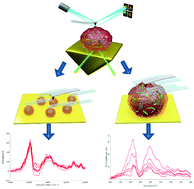当前位置:
X-MOL 学术
›
Nanoscale Horiz.
›
论文详情
Our official English website, www.x-mol.net, welcomes your feedback! (Note: you will need to create a separate account there.)
None of us is the same as all of us: resolving the heterogeneity of extracellular vesicles using single-vesicle, nanoscale characterization with resonance enhanced atomic force microscope infrared spectroscopy (AFM-IR)
Nanoscale Horizons ( IF 9.7 ) Pub Date : 2018-04-04 00:00:00 , DOI: 10.1039/c8nh00048d Sally Yunsun Kim 1, 2, 3, 3, 4 , Dipesh Khanal 1, 2, 3, 3, 4 , Priyanka Tharkar 1, 2, 3, 3, 4 , Bill Kalionis 3, 5, 6, 7, 8 , Wojciech Chrzanowski 1, 2, 3, 3, 4
Nanoscale Horizons ( IF 9.7 ) Pub Date : 2018-04-04 00:00:00 , DOI: 10.1039/c8nh00048d Sally Yunsun Kim 1, 2, 3, 3, 4 , Dipesh Khanal 1, 2, 3, 3, 4 , Priyanka Tharkar 1, 2, 3, 3, 4 , Bill Kalionis 3, 5, 6, 7, 8 , Wojciech Chrzanowski 1, 2, 3, 3, 4
Affiliation

|
Extracellular vesicles (EVs) are highly specialized, nanoscale messengers that deliver biological signals and in doing so mediate intercellular communication. Increasing evidence shows that within populations of EVs, important properties including morphology, membrane composition, and content vary substantially. This heterogeneity arises in response to the nature, state, and environmental conditions of the cell source. However, currently there are no effective approaches, which unequivocally discriminate differences between individual EVs, which critically hampers progress in this emerging scientific area. Measuring EV heterogeneity is paramount to our understanding of how EVs influence the physiological and pathological functions of their target cells. Moreover, understanding EV heterogeneity is essential for their application as diagnostics and therapeutics. We propose an innovative approach using resonance enhanced atomic force microscope infrared spectroscopy (AFM-IR) to identify the nanoscale structural composition of EVs, as demonstrated and validated using EVs derived from two types of placenta stem cells. The particular strength of this approach is that it is a label-free and ultra-high sensitivity technique that has the power to measure individual EV heterogeneity. New insights gained by this method into EV heterogeneity will have a profound impact not only on our basic understanding of EV biology but also on disease diagnostics and the emerging area of EV-therapies.
中文翻译:

我们每个人都与众不同:使用单囊泡,共振增强原子力显微镜红外光谱(AFM-IR)进行纳米表征以解决细胞外囊泡的异质性
细胞外囊泡(EV)是高度专业化的纳米级信使,可传递生物信号并以此介导细胞间的通讯。越来越多的证据表明,在电动汽车群体中,包括形态,膜组成和含量在内的重要特性存在很大差异。这种异质性是根据细胞来源的性质,状态和环境条件而产生的。但是,目前尚无有效的方法来明确区分各个电动汽车之间的差异,从而严重阻碍了这一新兴科学领域的进步。测量电动汽车的异质性对于我们了解电动汽车如何影响其靶细胞的生理和病理功能至关重要。而且,理解EV的异质性对于其在诊断和治疗中的应用至关重要。我们提出了一种使用共振增强原子力显微镜红外光谱(AFM-IR)鉴定EV的纳米级结构组成的创新方法,这是使用衍生自两种类型的胎盘干细胞的EV进行证实和验证的。这种方法的特别之处在于,它是一种无标签的超高灵敏度技术,能够测量各个EV的异质性。通过这种方法获得的关于电动汽车异质性的新见解,不仅会对我们对电动汽车生物学的基本理解产生深远影响,而且还将对疾病诊断和电动汽车疗法的新兴领域产生深远影响。我们提出了一种使用共振增强原子力显微镜红外光谱(AFM-IR)鉴定EV的纳米级结构组成的创新方法,这是使用衍生自两种类型的胎盘干细胞的EV进行证实和验证的。这种方法的特别之处在于,它是一种无标签的超高灵敏度技术,能够测量各个EV的异质性。通过这种方法获得的关于电动汽车异质性的新见解,不仅会对我们对电动汽车生物学的基本理解产生深远影响,而且还将对疾病诊断和电动汽车疗法的新兴领域产生深远影响。我们提出了一种使用共振增强原子力显微镜红外光谱(AFM-IR)鉴定EV的纳米级结构组成的创新方法,这是使用衍生自两种类型的胎盘干细胞的EV进行证实和验证的。这种方法的特别之处在于,它是一种无标签的超高灵敏度技术,能够测量各个EV的异质性。通过这种方法获得的关于电动汽车异质性的新见解,不仅会对我们对电动汽车生物学的基本理解产生深远影响,而且还将对疾病诊断和电动汽车疗法的新兴领域产生深远影响。这种方法的特别之处在于,它是一种无标签的超高灵敏度技术,能够测量各个EV的异质性。通过这种方法获得的关于电动汽车异质性的新见解,不仅会对我们对电动汽车生物学的基本理解产生深远影响,而且还将对疾病诊断和电动汽车疗法的新兴领域产生深远影响。这种方法的特别之处在于,它是一种无标签的超高灵敏度技术,能够测量各个EV的异质性。通过这种方法获得的关于电动汽车异质性的新见解,不仅会对我们对电动汽车生物学的基本理解产生深远影响,而且还将对疾病诊断和电动汽车疗法的新兴领域产生深远影响。
更新日期:2018-04-04
中文翻译:

我们每个人都与众不同:使用单囊泡,共振增强原子力显微镜红外光谱(AFM-IR)进行纳米表征以解决细胞外囊泡的异质性
细胞外囊泡(EV)是高度专业化的纳米级信使,可传递生物信号并以此介导细胞间的通讯。越来越多的证据表明,在电动汽车群体中,包括形态,膜组成和含量在内的重要特性存在很大差异。这种异质性是根据细胞来源的性质,状态和环境条件而产生的。但是,目前尚无有效的方法来明确区分各个电动汽车之间的差异,从而严重阻碍了这一新兴科学领域的进步。测量电动汽车的异质性对于我们了解电动汽车如何影响其靶细胞的生理和病理功能至关重要。而且,理解EV的异质性对于其在诊断和治疗中的应用至关重要。我们提出了一种使用共振增强原子力显微镜红外光谱(AFM-IR)鉴定EV的纳米级结构组成的创新方法,这是使用衍生自两种类型的胎盘干细胞的EV进行证实和验证的。这种方法的特别之处在于,它是一种无标签的超高灵敏度技术,能够测量各个EV的异质性。通过这种方法获得的关于电动汽车异质性的新见解,不仅会对我们对电动汽车生物学的基本理解产生深远影响,而且还将对疾病诊断和电动汽车疗法的新兴领域产生深远影响。我们提出了一种使用共振增强原子力显微镜红外光谱(AFM-IR)鉴定EV的纳米级结构组成的创新方法,这是使用衍生自两种类型的胎盘干细胞的EV进行证实和验证的。这种方法的特别之处在于,它是一种无标签的超高灵敏度技术,能够测量各个EV的异质性。通过这种方法获得的关于电动汽车异质性的新见解,不仅会对我们对电动汽车生物学的基本理解产生深远影响,而且还将对疾病诊断和电动汽车疗法的新兴领域产生深远影响。我们提出了一种使用共振增强原子力显微镜红外光谱(AFM-IR)鉴定EV的纳米级结构组成的创新方法,这是使用衍生自两种类型的胎盘干细胞的EV进行证实和验证的。这种方法的特别之处在于,它是一种无标签的超高灵敏度技术,能够测量各个EV的异质性。通过这种方法获得的关于电动汽车异质性的新见解,不仅会对我们对电动汽车生物学的基本理解产生深远影响,而且还将对疾病诊断和电动汽车疗法的新兴领域产生深远影响。这种方法的特别之处在于,它是一种无标签的超高灵敏度技术,能够测量各个EV的异质性。通过这种方法获得的关于电动汽车异质性的新见解,不仅会对我们对电动汽车生物学的基本理解产生深远影响,而且还将对疾病诊断和电动汽车疗法的新兴领域产生深远影响。这种方法的特别之处在于,它是一种无标签的超高灵敏度技术,能够测量各个EV的异质性。通过这种方法获得的关于电动汽车异质性的新见解,不仅会对我们对电动汽车生物学的基本理解产生深远影响,而且还将对疾病诊断和电动汽车疗法的新兴领域产生深远影响。


























 京公网安备 11010802027423号
京公网安备 11010802027423号